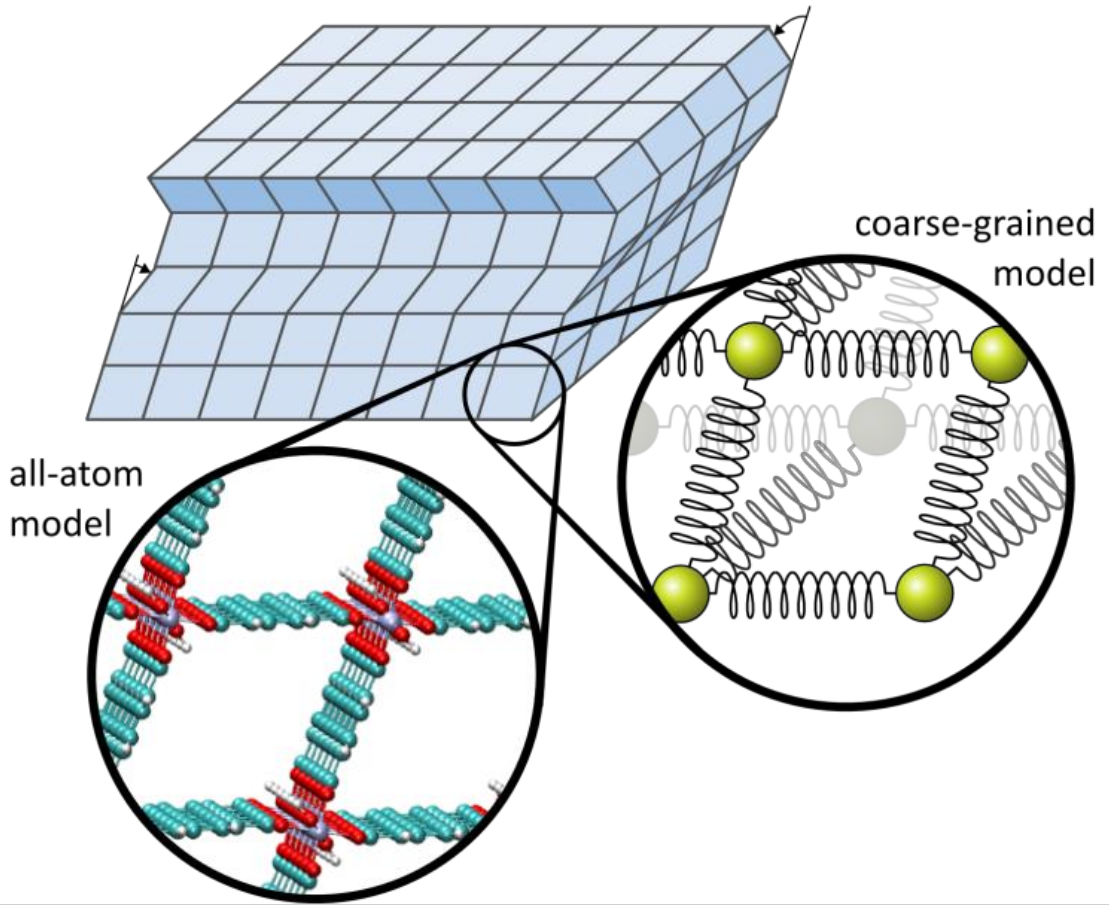Exploring the feasibility of MOF/polymer hybrid materials via the development of coarse-grained models
Exploring the feasibility of MOF/polymer hybrid materials via the development of coarse-grained models
Promotor(en): V. Van Speybroeck, T. Verstraelen /17MODEV11 / Model and software developmentMetal-organic frameworks (MOFs) are an increasingly attractive class of nanoporous materials. Their scaffold-like structure consists of two types of so-called secondary building units: inorganic moieties and organic linkers connecting these inorganic bricks. Due to the large versatility in possible secondary building units, a huge amount of MOFs can theoretically be synthesized, where the choice of building units also determines the functionality of the resulting MOF. With this in mind, thousands of MOFs have been synthesized with applications in gas storage and separation (for instance CO2 capture), drug delivery, nanosensing, radioactive waste scavenging, etc. However, many MOFs can only be synthesized in small crystals. To further shape these MOFs into pellets, they are subject to high pressures, possibly compromising the crystalline structure. This issue can be overcome by developing hybrid mixed matrix membranes, where the MOF is placed inside a polymer matrix (see Figure 1). The polymer host matrix then ensures the stability of the hybrid material, while the MOF functionality is retained. However, it is unclear which MOF/polymer combinations are compatible, and which combinations need to be chosen to obtain materials which are sufficiently stable for the envisaged applications. To understand the compatibility in these mixed matrix membranes, first steps were recently taken by our collaborators at the University of Montpellier [1, 2], albeit at a relatively small scale.

Goal
To aid the experimental exploration of MOF/polymer materials and ensure the compatibility of MOF and polymer, coarse-grained molecular mechanics can play a prominent role. Indeed, to adequately describe the MOF/polymer interface, large simulation cells, containing about 10 000 – 1 000 000 atoms, need to be considered. Full quantum mechanical calculations are computationally too demanding and are in practice only applicable to relatively small systems (< 500 atoms) and short simulation times. Instead, coarse-grained force fields must be used to obtain the required upscale in system size. In these force fields, the potential energy surface is approximated by an analytical expression–a topic in which the CMM already has a lot of experience. Second, a coarse-graining procedure is applied, in which neighboring atoms are collected in coarser beads, and the interactions between these beads are described (see Figure 2). These coarse-grained force fields, which need to be developed for each MOF/polymer combination, are then used in molecular simulations to mimic the behavior of the hybrid material, especially in the vicinity of their interface.

The University of Montpellier and the University of Bochum, with which the CMM extensively collaborates, were amongst the first to adopt such a coarse-grained strategy to model MOF/polymer hybrids [3]. Two main coarse-graining techniques can be defined. In first generation coarse-grained force fields, the bead parameters are chosen such that the potential energy surface of the material is well reproduced. However, since an increasing amount of MOFs are shown to be flexible, and hence undergo large-amplitude deformations, second generation force fields also include mechanical features to accurately describe their resistance against stresses. However, given their recent development, a large-scale validation and exploration is yet to be performed.
In this thesis, the student will derive coarse-grained force field models for the relevant materials. For MOFs, these materials include the usual suspects (ZIF-8, UiO-66, HKUST-1), while the choice of polymers (PIM, PVA) will be based on expertise present at the University of Montpellier. These coarse-grained models are then thoroughly validated, and subsequently used in molecular simulations to assess their applicability. The final goal is then to evaluate the feasibility of incorporating the different MOFs in the studied polymers, yielding invaluable input for experimentalists. Moreover, it will also be possible to benchmark the aggregation of MOF particles inside these membranes based on state-of-the-art results obtained at the University of Versailles.
Aspects
Physics aspect: Derivation of a coarse grained model, starting from interactions on a molecular level.
Engineering aspect: Exploration of the possible MOF/polymer combinations on a macroscopic scale.
- Study programmeMaster of Science in Engineering Physics [EMPHYS], Master of Science in Physics and Astronomy [CMFYST]ClustersFor Engineering Physics students, this thesis is closely related to the cluster(s) NANO, MODELLINGKeywordsCoarse graining, Force fields, molecular simulations, hybrid materials, Analysis, material explorationReferences
[1] R. Semino, N. A. Ramsahye, A. Ghoufi and G. Maurin, "Microscopic model of the metal-organic framework/polymer interface: A first step toward understanding the compatibility in mixed matrix membranes," ACS Appl. Mater. Interfaces, vol. 8, no. 1, pp. 809-819, 2016.
[2] R. Semino, N. A. Ramsahye, A. Ghoufi and G. Maurin, "Role of MOF surface defects on the microscopic structure of MOF/polymer interfaces: A computational study of the ZIF-8/PIMs systems," Micropor. Mesopor. Mater., 2017. DOI: 10.1016/j.micromeso.2017.02.031.
[3] J. P. Dürholt, R. Galvelis and R. Schmid, "Coarse graining of force fields for metal-organic frameworks," Dalton Trans., vol. 45, no. 10, pp. 4370-4379, 2016.


